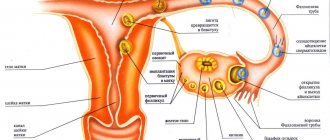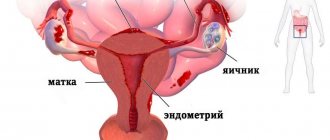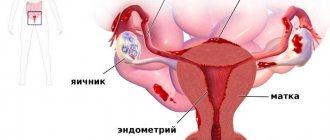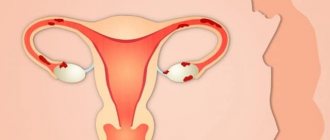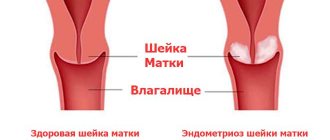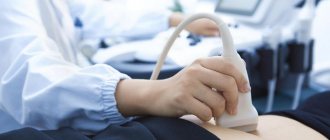IMMA clinics provide services for examination, diagnosis and treatment of women's diseases. One of the most common reasons for visiting a doctor is a suspicion of endometriosis and complaints about worsening health and pain. This is truly a serious reason not only to visit a doctor, but also to prescribe a comprehensive examination. According to statistics, endometriosis causes almost 50% of infertility in women of childbearing age. Early diagnosis and preventive measures will help cope with this problem with minimal effort, time and money. The Association of Medical Clinics IMMA includes 6 modern outpatient clinics in different districts of Moscow. We can serve the whole family; our staff includes both general and highly specialized specialists, for adults and children.
In our clinics you can:
- Get a consultation with a gynecologist;
- Receive pregnancy planning services;
- Undergo hysteroscopy;
- Remove vaginal cyst;
- Treat cervical erosion with radio wave coagulation;
- Get professional advice from other specialists and much more!
For more details and any questions, please contact the number listed on the website.
Pain as a key symptom of the disease
According to medical statistics, pelvic pain occurs with internal and external endometriosis. Their frequency reaches from 25 to 90%. This scatter of data is due to the peculiarities of conducting clinical studies. Practicing gynecologists indicate that complaints of pain of various localizations occur in every second patient diagnosed with endometriosis.
Pain is the main reason for visiting a doctor. The examination also reveals other associated symptoms:
- Heavy and prolonged menstruation;
- Perimenstrual discharge: dark brown, scanty, 1-2 days before and after menstruation.
In addition to pain, endometriosis is also characterized by long, heavy menstruation.
Such symptoms are characteristic of damage to the uterus - adenomyosis. With endometriosis of the ovaries, fallopian tubes, and vagina, the main manifestation of the disease remains pain. Some forms of endometriosis lead to infertility or cause miscarriage. Difficulty conceiving a child is another common reason for visiting a doctor.
For your information
Chronic pelvic pain is not limited to endometriosis. Such symptoms are typical for uterine fibroids, ovarian cysts and some other diseases. The doctor will be able to make an accurate diagnosis after a complete examination of the patient.
Causes of pain with endometriosis
The genesis of the disease is still not fully understood, and it is impossible to say for sure why the pain syndrome occurs. The following reasons for the appearance of unpleasant sensations are identified:
- The phenomenon of micromenstruation. The focus of endometriosis is a cluster of cells similar to the cells of the mucous layer of the uterus. They are sensitive to the influence of female sex hormones - estrogen and progesterone, and behave exactly like normal tissues. Before menstruation, heterotopias increase in size, and characteristic pelvic pain appears. During menstruation, tissue rejection and bleeding occur. The blood does not find a way out of the tissues located outside the uterine cavity, and regular pain occurs;
- Aseptic inflammation. In areas of endometriosis, minor bleeding develops monthly. Blood accumulates in the tissues without finding a way out, and aseptic inflammation develops (without pathogenic microorganisms). The inflammatory focus becomes a source of pelvic pain. Over time, unpleasant sensations arise not only during menstruation, but also on other days of the cycle;
- Adhesive process. Aseptic inflammation leads to the appearance of adhesions in the lumen of the fallopian tubes, on the ovaries, and pelvic ligaments. Adhesions hold the organs in a stationary position and lead to pain in the lower abdomen, lower back, and perineum;
Pain syndrome can be caused by adhesions in the pelvis.
- Damage to nerve fibers. Foci of endometriosis compress the structures of the nervous system and destroy them during invasive growth. This explains the fact that the severity of the pain syndrome does not always correspond to the severity of the pathological process, and with a small distribution of foci, severe pain is noted;
- Sensory potential of heterotopias. Some studies show that cells in endometriosis lesions can independently generate impulses and create the sensation of pain. There is evidence that heterotopias form their own innervation;
- Immunological failure. It is assumed that the pain syndrome is associated with a decrease in the activity of natural killer cells and the growth of macrophages. The latter release cytokines leading to the development of the inflammatory process and the appearance of pain;
- Psychogenic mechanisms. The medical literature describes cases where pain increased after a woman learned about her diagnosis. As a result, the pain, which until now has not caused a significant negative reaction, becomes quite severe. The severity of unpleasant symptoms in this situation depends on the personality of the patient, and not on the severity of the disease. A similar clinical picture is more often observed in women who are anxious, suspicious, and inclined to demonstrate their experiences.
It is also useful to read: Drug treatment of endometriosis
Folk remedies
If intestinal endometriosis is diagnosed, symptoms are noticeable and treatment is started, then in addition to it you can use some folk remedies. Just before starting treatment with traditional methods, you should contact a gynecologist and consult. After all, many intestinal diseases have similar symptoms, and you need to make sure that you are treating endometriosis.
- To prepare a decoction of viburnum flowers, take a glass of water per 20 g of flowers. The mixture is brought to a boil, kept on fire for several minutes, then cooled and filtered. Drink 70 ml twice a day.
- To prepare an infusion of celandine, take 2 teaspoons of dried and crushed herbs, add a glass of hot water and infuse. You should take this folk remedy one tablespoon three times a day, but not longer than 10 days.
- Medical leeches. This folk remedy, proven over the years, helps improve blood microcirculation and saturate cells with oxygen. Many doctors say that leeches normalize hormonal balance and can prevent recurrence of endometriosis.
In addition to the above, there are many different folk methods.
Freshly squeezed beet juice, St. John's wort tea, etc. help well. However, it should be remembered that most often folk remedies help get rid of the symptoms of pathology, but the causes of its occurrence are not addressed. Therefore, doctors recommend the use of traditional methods in addition to complex drug treatment, for example, to get rid of pain during menstruation.
The nature of pain syndrome in endometriosis of various localizations
Clinical manifestations of pelvic pain:
- Algodysmenorrhea is pain during menstruation. Discomfort is felt in the lower abdomen, in the lumbar region and sacrum, in the perineum. In rare cases, the discomfort goes to the thigh, but not lower (pain in the legs is not typical for the pathology). The pain is nagging, aching, and can be cramping. They appear a few days before menstruation, persist throughout the entire period of discharge and 1-2 days after its completion. A characteristic sign of adenomyosis is damage to the uterus;
Endometriosis is characterized by severe pain in the lower abdomen during menstruation.
- Dyspareunia is pain during sexual intercourse. It is observed with any type of intimacy and orgasm. A characteristic symptom of endometriosis of the pelvic peritoneum, cervix, vagina;
- Dysuria is pain when urinating. Unpleasant sensations occur during emptying of the bladder and intensify during menstruation. Localization of pain is the perineum, lower abdomen, less often the back (lower back). A characteristic sign of extragenital endometriosis with damage to the urinary tract;
- Dyschezia is pain during defecation. Localization: perineum, rectum, sacral area. It is noted when the intestines are damaged.
Pain syndrome can manifest itself in different ways. Some women complain of unpleasant sensations in the lower abdomen during menstruation, which radiate to the intestines. Others note that the right or left side hurts. Still others say that discomfort is felt in the perineum. An asymptomatic course of the disease is also possible.
It is important to know
Endometriosis is not characterized by headaches and muscle pain (in the arms and legs). If such symptoms appear, consultation with specialized specialists is necessary. There may be chest pain, but they are not associated with the underlying disease, but are the result of hormonal disorders.
The intensity of the pain syndrome is not directly related to the severity of the pathological process. The medical literature (L.V. Adamyan, 1998) provides evidence that even minimal forms of endometriosis on the pelvic peritoneum can lead to unbearable pain. At the same time, large ovarian cysts can be practically asymptomatic or cause minor discomfort in the middle of the cycle (during ovulation). More recent studies (E.L. Yarotskaya, 2004) indicate that there is no clear connection between the prevalence of heterotopias in the peritoneum and the intensity of pain. At the same time, evidence is provided that the depth of penetration of the lesions influences the course of the disease.
Conclusions:
- The localization of pain is determined by the spread of endometriosis foci throughout the pelvic structures and extragenital organs;
The localization of pain depends on the location of the foci of endometriosis.
- The intensity of pain does not depend on the extent of the process. Often severe discomfort is observed with minimal lesions;
- The severity of pain depends on the depth of penetration of the lesion. Infiltrative endometriosis of the peritoneum leads to unbearable pain;
- The intensity of the pain syndrome may be related to the location of the lesion. The most severe pain is observed with endometriosis of the uterine ligaments and rectovaginal septum. Unpleasant sensations associated with an ovarian cyst usually occur with microperforation of formations and the development of chemical peritonitis;
- Cyclic pain is characteristic of damage to the pelvic organs. Non-cyclical constant or recurrent occur when the process is localized in the rectum and other extragenital organs;
- In women with the same diagnosis and identical forms of endometriosis, the severity of the pain syndrome will be different. Mild, barely noticeable discomfort and unbearable pain are possible. An asymptomatic course of the pathology cannot be ruled out.
On a note
The American Association of Gynecologic Endoscopists (AAGL) is developing a classification system for the disease that will be based on the nature of the pain syndrome. This will change the approach to diagnosing pathology and help select the optimal treatment tactics.
Consequences of pain syndrome for women
Persistent or recurrent discomfort in the pelvic area is not just discomfort. Clinical studies show that pain becomes a source of other problems:
- The quality of sexual life decreases and dissatisfaction with sexual contacts is noted;
Due to constant pain with endometriosis, a woman is often forced to refuse intimacy.
- The level of anxiety increases, the risk of developing depression increases;
- There is a need to take painkillers, which negatively affects the functioning of internal organs.
Pain is a signal from the body that something is wrong and should not be ignored. At the first symptoms of the disease, you need to consult a doctor, undergo examination and treatment. Refusal of the proposed therapy threatens to worsen the woman’s condition. The discomfort will increase. At the same time, the risk of complications will increase:
- Uterine bleeding. Against the background of progressive adenomyosis, curettage of the uterine cavity is required to stop bleeding;
- Anemia. Blood loss due to endometriosis of the uterus leads to a decrease in hemoglobin levels and oxygen starvation of tissues;
- Infertility. Many forms of endometriosis make it difficult to conceive a child. The cause of infertility is hormonal imbalance, immunological disorders, adhesions in the pelvic organs and other factors;
- Miscarriage. Against the background of the disease, the risk of spontaneous miscarriage, improper attachment of the placenta and other complications increases.
It is also useful to read: Removal of the uterus for endometriosis
Complications
If you do not pay attention to the symptoms of the disease and do not treat it, complications may arise:
- adhesions, which in the future can lead to intestinal obstruction,
- narrowing of the intestinal lumen,
- bleeding from the anus,
- rupture of the intestinal wall,
- oncology in the intestines,
- inflammatory processes in the peritoneum.
Every woman needs to know what kind of disease endometriosis is and what its symptoms are. This is necessary in order to notice changes in your body in time and contact a gynecologist. After all, if the pathology is discovered late enough, its treatment will be difficult, and the woman will already suffer from many unpleasant symptoms, such as pain.
And in order to reduce the risk of developing this pathology, care should be taken in prevention. To do this, it is necessary to periodically visit a gynecologist, promptly cure all diseases of the reproductive system, especially inflammatory ones, and lead a healthy lifestyle with feasible physical activity. Such preventive measures will allow you not to detect unpleasant symptoms of endometriosis and not suffer from this insidious disease.
Diagnostic search for chronic pelvic pain
Pain in the lower abdomen occurs with various diseases of the pelvic and abdominal organs. The following methods will help you make an accurate diagnosis:
- Examination by a gynecologist. The doctor pays attention to the nature of the complaints and assesses the woman’s general condition. It is important to identify hereditary predisposition and other risk factors: previous childbirths and abortions, instrumental interventions and surgeries on the pelvic organs, reproductive function, features of the menstrual cycle, concomitant diseases;
- Bimanual examination. With adenomyosis, the uterus is enlarged and spherical in shape. An endometrioid ovarian cyst is defined as a round formation in the projection of the organ. Foci of other localization are not detected by palpation, but there may be local pain;
- Ultrasonography. Ultrasound can reveal adenomyosis, ovarian cyst and other forms of pathology based on characteristic echo signs;
- Magnetic resonance imaging. A highly informative research method that allows you to identify small foci of endometriosis and distinguish pathology from other diseases of the pelvic organs;
Magnetic resonance imaging helps determine the areas of endometriosis and the stage of the disease.
- Colposcopy. Used to diagnose endometriosis of the cervix and vagina. Combined with targeted biopsy - tissue sampling for histological examination;
- Aspiration biopsy. Sampling the endometrium to evaluate its structure helps identify adenomyosis;
- Hysteroscopy. Examination of the uterine cavity is indicated if adenomyosis is suspected. During the procedure, you can take material for histological examination;
- Diagnostic laparoscopy is the gold standard for diagnosing endometriosis of the peritoneum and other pelvic structures. Allows you to identify the location of lesions, assess their depth, extent, and take tissue for morphological examination.
Diagnosis of endometriosis at the preoperative stage is difficult. The variety of clinical forms and the absence of specific symptoms do not allow the doctor to make an accurate diagnosis without the use of special research methods. Often, pathology is detected only after histological analysis and laparoscopy.
How to diagnose and treat intestinal endometriosis?
Most women believe that endometriosis is a disease that affects only the organs of the reproductive system. Indeed, with this pathology, endometrial cells, normally located on the inner surface of the uterus, spread beyond their usual location.
But endometriosis is insidious in that it can spread to other organs. And at the same time, it practically does not manifest itself, which makes it much more difficult to make a correct diagnosis. One of these insidious forms of this pathology is intestinal endometriosis.
Methods for relieving pain in endometriosis
There are three areas of treatment for endometriosis:
- Relief of pain and normalization of the menstrual cycle;
- Restoration of reproductive function;
- Prevention of disease relapse.
Taken together, these measures can relieve unpleasant symptoms and make a woman’s life easier.
In the treatment of external endometriosis, the main emphasis is on surgical correction. The volume of the operation depends on the localization and extent of the process:
- Endometrioid ovarian cysts are excised, the tissue is sutured or coagulated. If healthy organ tissue is completely replaced by the formation, an oophorectomy is performed. Removal of the ovary is also indicated during menopause;
If the ovary is deeply affected by endometriosis, removal of the organ may be necessary.
- Lesions on the sheets of the peritoneum and pelvic ligaments are excised or cauterized with a laser. The adhesions are cut, the affected organs are released, and the lumen in the fallopian tubes is restored;
- For cervical endometriosis, cauterization of the lesion with radio waves, laser or electric current is indicated. In case of extensive damage, conization of the cervix is performed.
In the treatment of internal and external endometriosis, hormonal drugs are used for a course of 3 months. The goal of treatment is to achieve regression of the lesions. Heterotopias decrease in size, the menstrual cycle is restored, and pain goes away. A combination of conservative and surgical treatment is practiced.
For your information
According to medical literature, the use of hormonal drugs after surgery increases the effectiveness of surgical treatment by 25%.
In 2011, at the World Congress on Endometriosis, dienogest was proposed as a first-line drug.
Drugs containing dienogest are first-line drugs for endometriosis.
It is suitable for long-term treatment of the disease - 6-9 months. Unlike other hormonal medications, it not only leads to regression of endometrioid lesions, but also eliminates pain. Research on the effect of the drug on a woman’s body continues, but today dienogest is considered one of the best remedies. It is well tolerated, rarely causes serious side effects, and is suitable for use in women of reproductive age and premenopause (after 40 years). Reviews from doctors regarding dienogest are mostly positive.
Symptomatic therapy for endometriosis is aimed at relieving pain. Drugs from the following groups are prescribed:
- Non-steroidal anti-inflammatory drugs. They are used in a short course, prescribed mainly during menstruation. Relieve inflammation, eliminate pain, alleviate the general condition of a woman;
- Antispasmodics. They are used mainly for adenomyosis. Relaxes the muscles of the uterus, relieves pain during menstruation.
Antispasmodic and anti-inflammatory drugs (suppositories and tablets) have an analgesic effect, but do not affect the cause of the disease. They will not help remove foci of endometriosis and cannot be a complete replacement for treatment. Such drugs are prescribed only in addition to the main therapy. Long-term use of NSAIDs and antispasmodics negatively affects the functioning of internal organs and can lead to exacerbation of chronic pathology.
Why does pain occur with endometriosis? Detailed answer from a specialist
Diagnostics
Since very often there are practically no symptoms of this disease in the initial stages, it is usually detected in two cases. Either the disease has spread so much that vivid symptoms appear, or with advanced gynecological endometriosis, the doctor referred the patient for a more complete examination.
But even if it is clear that, based on the detected symptoms, the patient has been diagnosed with intestinal endomeriosis, the gynecologist will in any case prescribe an additional examination before treatment. The most common methods that quite accurately indicate the presence of this disease in the body are the following:
- Irrigoscopy, which allows the doctor to see the entire intestine and notice pathological foci in it.
- Irrigography or fluoroscopic examination of the intestine using a special contrast agent. This method requires some preliminary preparation.
- Colonoscopy is a method in which the internal surface of an organ is examined using an endoscope. This method is very informative, but quite complicated.
- Fibercolonoscopy - with this method, the doctor inserts a fibercolonoscope (a special optical device) into the intestine, with the help of which this organ is examined. This method is quite traumatic for the intestines, but allows you to detect even small foci of the disease. Also, if necessary, the doctor will be able to take a biopsy or remove tumors.
- A biopsy is usually used in advanced cases of the disease to rule out the presence of an oncological process.
- Computed tomography and MRI make it possible to diagnose intestinal obstruction and formed adhesions.
- Diagnostic laparoscopy allows not only to detect pathological foci, but also to remove them in a timely manner.
For intestinal endometriosis, treatment is prescribed depending on the symptoms and the cause of this pathology. If the patient has a hormonal imbalance, then first of all you should start by treating it and getting rid of the accompanying symptoms, for which the gynecologist will prescribe hormonal medications. If the cause of endometriosis is inflammatory processes in the intestines, then complex treatment will necessarily include anti-inflammatory or antiviral drugs.

